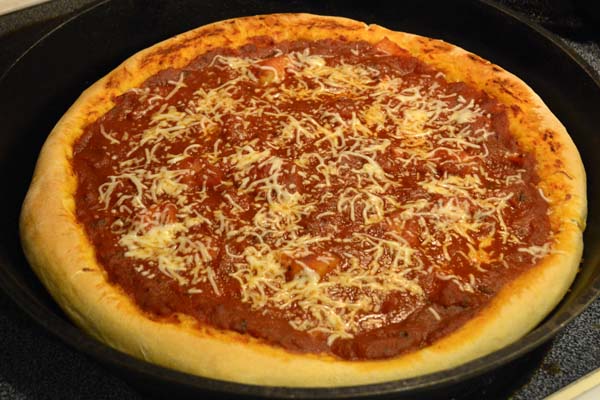| Home | Food |
Deep-dish Pizza
Our family has tried many times to make decent homemade pizza, without a lot of success. This is the first recipe I've made that is actually really good. The flour types and relative amounts can be varied to achieve different crust tastes and textures. The one given below is the one I prefer.
 |
| Large, deep-dish pizza with Canadian-style bacon and pineapple. |
The amounts below make enough dough for one medium and one large pizza.
Crust
- 1.5 cups water (room temperature or warm)
- 1 packet active or instant dry yeast (about 2 tsp)
- 2 teaspoons salt
- 1 teaspoon sugar
- 2 tablespoons olive oil
- About 3 to 4 cups of flour (I use at least half a cup of whole wheat flour and equal parts bread and all-purpose white flour)
Topping
- Mozzarella cheese (shredded), or
- Mozzarella, provolone, and Swiss cheese mixture (shredded)
- 42 to 56 oz. canned or bottled pizza sauce ("traditional" is my favorite, or make your own)
- Oregano, garlic, and onion powder to taste
- Optional: Canadian-style bacon, thinly sliced (1/2 pound is enough for two pizzas)
- Optional: Pineapple chunks, drained and cut to preferred size (a 20-oz. can is enough for two pizzas)
Dissolve yeast in water in a large bowl. Add the salt and sugar and stir until dissolved. Add a half a cup of all-purpose flour, a half a cup of bread flour, and a half a cup of whole-wheat flour and stir until mixed. Add olive oil and stir until mixed. Begin adding equal parts of bread flour and all-purpose flour, a half a cup of each at a time, and stir or knead with a wooden spoon or spatula until each addition of flour is absorbed into the dough before adding the next half-cup of flour. Feel free to adjust the proportion of flours to arrive at the type of dough you prefer; I like a total of about a cup of wheat flour and equal parts bread and all-purpse flour. When enough flour has been added to form a coherent dough mass, turn out the still sticky dough onto a flour-covered kneading surface and begin to knead the dough, adding flour as necessary until the dough is not overly sticky. Place the kneaded dough in a covered dough bin or bowl and allow it to rise until at least doubled in volume. The amount of time required will depend on the dough temperature, room temperature, and yeast activity, but could take three or four hours.
Once the dough has risen, turn out the dough on a floured surface, cut it into two portions that roughly match the relative amounts required for the pizza pans (if they are different sizes), and begin to press and roll the dough into thin, reasonably round sheets. While rolling and pressing, the dough will try to retract to its original size. When this happens, let the dough relax for a few minutes before trying to roll it out further. At this point, the dough can be tossed in the air with a twist to impress guests and help it spread out evenly.
When the dough has reached a diameter that is a little larger than the pan (for pans, I use cast-iron skillets that have been coated with a thin layer of olive oil), gently place the dough in the pan, spread it evenly, and make sure the edges extend a half an inch or so up the sides of the pan. Preheat the oven to 425 degrees F while letting the dough rise again for 30 to 45 minutes or so. To keep the dough warm and to prevent it from drying out, place the pans inside a large plastic bag while the dough rises and the oven preheats.
While the dough is rising in the pizza pans, add any desired spices to the pizza sauce (I like extra oregano, some minced garlic or garlic powder, and onion powder), warm the sauce on the stove at a low temperature, and prepare the toppings if desired. When the dough has risen a little, remove the pans from the plastic bags. Place a layer of shredded cheese (ideally a mixture of mostly mozzarella with lesser amounts of provolone and Swiss cheese) directly on top of the dough. Add the desired toppings on top of the cheese, and then ladle the pizza sauce on top of the shredded cheese and toppings (if any) and spread it evenly without disturbing the underlying cheese layer.
To bake, place the pans on the lower to middle levels of the preheated oven (a baking stone helps bring the bottom of the iron skillet to baking temperature more quickly) and cook for about 15 minutes. After about 15 minutes, swap the pan levels, moving the higher one to the bottom and the lower one to the middle. After another 10 minutes of baking, sprinkle a little shredded cheese on top of the pizzas and bake for another 5 minutes or so. After a total of about 30 minutes of baking, the sauce and toppings should be thoroughly heated, the additional cheese on top melted but not burned, and the crust browned on the bottom and sides. Cut and serve the pizza immediately in the pans.